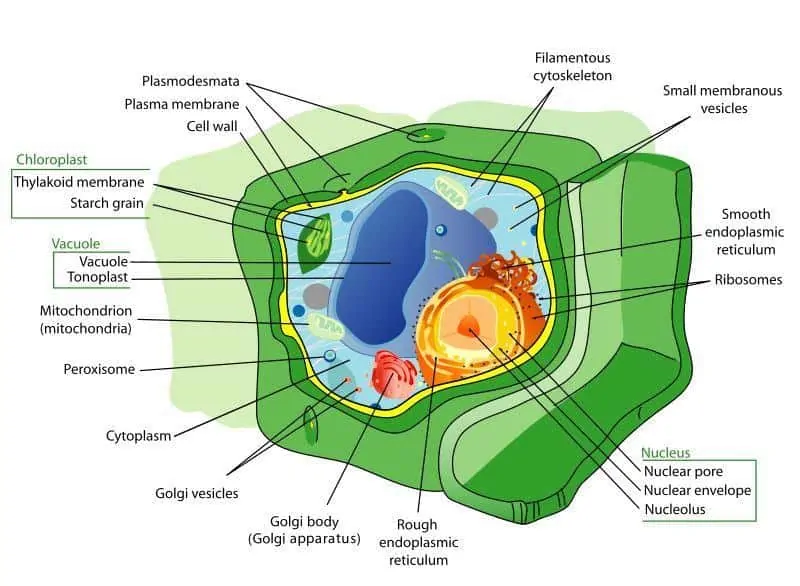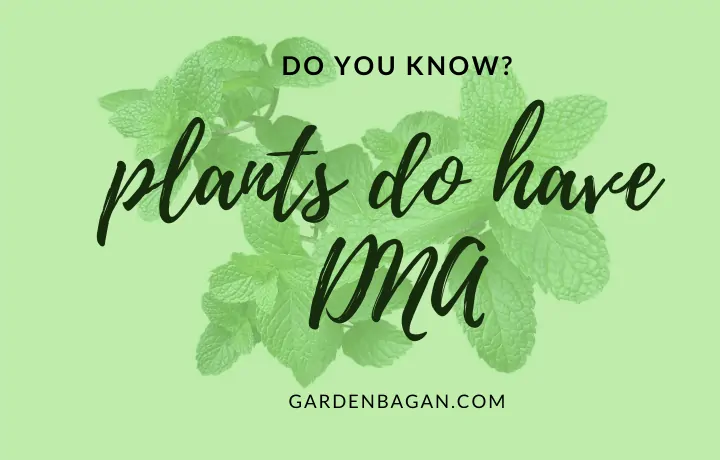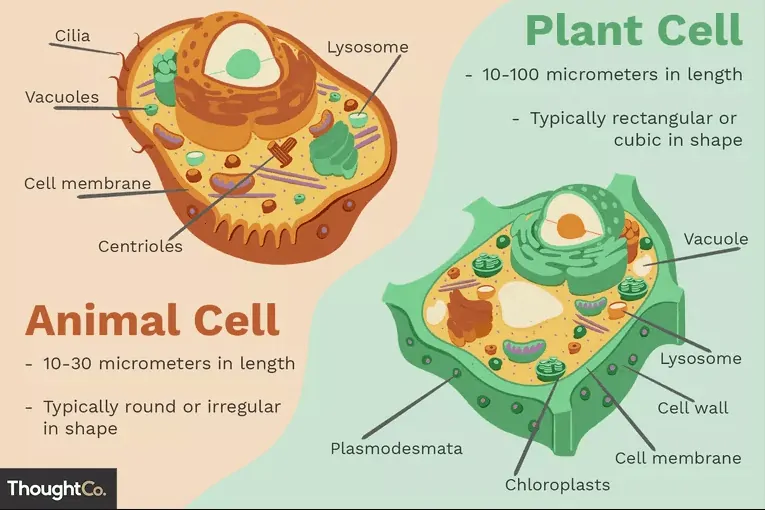Do plants have DNA?- Yes, they have. Plants, in all their shapes and sizes- do have DNA. It is the base of any specific characteristics like color, shape, size, flowers, fruits and everything seen in a plant.
Have you ever wondered how did living organisms come into existence?
We often hear words like the cell, DNA, genetics. And quite often we have heard about DNA TEST especially in a classic T.V. serial to find out who is the father of the child. Isn’t it interesting?
So what is a cell? What is DNA? And do PLANTS have DNA like us? before starting let’s first understand –

what are cells?
Cells are the basic structural units of a living organism. They are the building blocks of all living things on Earth.
Organism especially living one can be as small as a single-celled amoeba or may contain trillions of cells, like we humans do.
Talking about life Cells are everywhere. Cells are responsible to carry out the life process of an organism by providing structure to it.
Taking in nutrients from food, converting these nutrients into energy which thereafter helps that organism to work and carry out specialized functions is all a cell can do.
Cells contain a hereditary material called DNA. As one cell leads to the formation of another cell this DNA is passed on to each cell.

What is DNA?
DNA, commonly known as Deoxyribonucleic Acid.
It is a bunch of molecules stuck together in the shape of a ladder. It is the hereditary material or the blueprint for all living things and is present in every organism present on the earth.
You can easily Relate DNA with paperwork before starting any project or designing an algorithm before writing actual code, or simply a basic function for solving a mathematical problem.
DNA tells amino acids to align themselves to form the perfect protein shape that helps in the functioning of a living organism.
Amino acids are tiny little chemicals present inside an organism’s body that can take shape to form the protein.
An interesting and important property of DNA is that it can replicate, or make copies of itself. Here the term living comes into existence.
DNA lives inside the nucleus and it is a molecular blueprint of any living organism.
And it works by creating RNA, which in turn creates proteins and further carries out the process of forming or creating life.
But have ever wondered if plants and animals are also living beings. So do they also have DNA?
The answer is –Yes, like all living organisms plants also have DNA.
Plants use deoxyribonucleic acid (DNA) as their genetic material. DNA gives a coded set of instructions that make RNA.
All the functions of the plant cell are controlled and managed by the nucleus. It is the nucleus that also contains DNA that is assembled into its chromosomes.
It has been found that the majority of DNA of a plant is found in the nucleus.
The DNA of a plant is also present within the mitochondria (powerhouse)of plants cell and also within the chloroplasts of plants cell.
So we can say that plants have their DNA present in:
- Nucleus
- Mitochondria
- Chloroplasts
DNA in Mitochondria:
When a plant cell is studied under a light microscope, mitochondria are so large that it can be easily seen under it. In many pieces of research by fluorescence microscopy, even the mitochondrial DNA (mtDNA) is visible.
Mitochondrial DNA is found only in mitochondria thus it functions independently. It is the mitochondria which are known as the powerhouse of cells. Therefore all of the functions regarding the energy requirement of the cell take place in it.
Carbohydrates, fats, and proteins are broken down into their constituents (raw elements) inside the mitochondria with the release of energy.
DNA in Chloroplasts:
The second place in which DNA is housed or found outside the nucleus is the chloroplast- a very structural unit of the plant cells. It is in the chloroplasts where photosynthesis occurs.
Photosynthesis is the process by which plants make their own food. Chloroplast helps to transform carbon dioxide, water, and solar energy i.e. sun rays to produce food or sugars which are later converted into fats and proteins.
This is the unique and most essential process undertaken by plants which help to sustain life on earth. Do you know all the other living beings on the earth are dependent on plants for food?
Both mitochondrial DNA and chloroplastic DNA replicate and function separately from nucleus DNA.
DNA in Nucleus:
In animals and plants, DNA is stored inside the nucleus of the cell, whereas in bacteria and archaea, the DNA is present in the cell’s cytoplasm.
The plant cell is surrounded by the nuclear membrane which contains the nucleus. The color of the nucleolus of the cell is dark blue whereas the color of the nuclear membrane is yellow, and the color of the nucleus is light blue. You can observe it under a microscope.
Have you ever taken a look at plants that look exactly identical just like a Christmas Tree, it has seven times more genetic material (DNA) than a human being!
How is the DNA of PLANT been used by various researchers and scientists?
It is very well known that some plants live for more than a thousand years thus it is natural that they have the character that attracted researchers towards it.
Plants are capable of reproducing itself in a process known as self-replication done by its DNA. This property allows cell division and thus leading to continuity, growth, and repair.
Researchers have found that plants are easy to manipulate by doing changes in their DNA and therefore the plant DNA after the bacterial DNA is a primary experimental subject for bioengineers.
The process of photosynthesis enables the plants to make their own food and also becoming the major food source for human and livestock populations. For years many research has been done regarding the commercialization of this particular aspect of the plant kingdom.
With the constant growth in population, the demand for food has also gone up. In order to meet the demand for food of rising population researchers have genetically modified plants to develop higher resistance from insects, bacteria, viruses, and other pests.
Increasing the yield is always the prime objective of such researches.
By genetically modifying plant crops they are able to enhance and modify a variety of food from plants which make it look and taste even better.
Genetic modification has lead to faster-growing or ripening of food which in turn has lead to more slowly to having no seeds.
Nowadays with the advancement of technology and development of Research and development centers scientists are trying to modify plant DNA in order to develop future crops. These crops may contain human vaccines, human hormones, and other pharmaceutical products.
In the future, it may be possible to say for truly that “An apple a day keeps the doctor away“.
How is a PLANT’s DNA different from ANIMAL’s DNA?
All plants and all animals contain DNA that has the same shape which is the famous “double helix” that looks like a twisted ladder.
The only difference between the two is how their four nucleotides in DNA are arranged. It’s their sequence that determines which proteins will be made.
The way in which the nucleotides are arranged and the information they encode determines and decides what it becomes in the future. It will decide whether the organism will produce scales or leaves. Will it become a plant or will have legs or a stalk to become an animal.
Animals have more chromosomes whereas plants have fewer chromosomes. Every living organism whether is a plant or an animal has a defined number of chromosomes called the chromosome number.
Differences between Plant Cell and Animal Cell:
| Plant Cell | Animal Cell |
|
|
How is a PLANT’s DNA different from a HUMAN’s DNA??
The only and the most significant difference between plant DNA and humans DNA is that humans do not contain chloroplasts. Otherwise, you may look green and spend all your day being naked out in the sun.
Plants are capable of making their own food by the process of photosynthesis whereas humans depend on other living things for survival and for their food.
Thus it can be said that Plants do have DNA just like humans but it is different from the DNA of any other living organism.

